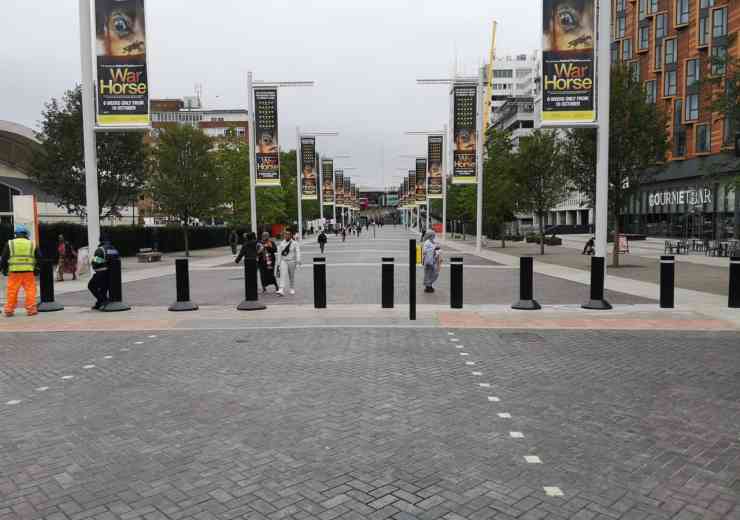Designing and developing effective protection

Developing hostile vehicle mitigation (HVM) measures with industry that can effectively blend into a range of public realm and private site scenarios is the challenge that faces a team of specialists at the UK’s Centre for the Protection of National Infrastructure (CPNI). CPNI is the UK government authority that provides protective security advice to the businesses and organisations of the national infrastructure.
Protection options for more industrial and military sites have been effectively fulfilled over the past years through a range of functional access control and perimeter protection systems. However, the challenges of protecting architecturally delicate, and pedestrian and utility-rich public realm sites have required lateral thinking and a vigorous research and development programme by CPNI and industry. Some of the results lie not only in new materials and construction techniques but also in new project management methods and partnerships with local authorities, urban planning professionals, architects and designers.
New developments
“Shallower”, “more economic” and “more aesthetically attractive” are the three main tenets by which CPNI direct their research and development work in this field. Examples of newer developments in the impact resistant product market include: “sprung steel” cores that can be shrouded in less voluminous shrouds and street furniture items; incredibly shallow-plated or framed bollard systems that reduce the need to divert utilities; polycarbonate bollards through which light can be shone to give more artistic protective security streetscape enhancements; cycle stands and surface-pinned planters; and blast resistant and shallower foundation walling and balustrade systems.
Public realm design guide
CPNI has worked with the urban planning and landscape architecture profession to produce guidance, to be published shortly, showing how design can be used to create HVM measures; providing inspiration and ideas for the integration of HVM measures within the public realm; giving example scenarios to show how a designer might approach the integration process; and listing important points to consider for a structured and thorough design process. It contains useful references, contacts, sources of information and precedents. Crucially, it has been written by designers for designers, based on the strong foundations from CPNI’s physical security research programme.
Vehicle borne threats
There are five styles of vehicle borne threat, typically Vehicle Borne Improvised Explosive Devices (VBIEDs), against which CPNI recommend that sites should consider protecting themselves.
The parked vehicle threat: Encroachment threat; no impact takes place but a vehicle meanders its way through a clear route in the defences because the line of defence is incomplete; or the defences are inappropriately spaced (wider than a 1.2 metre air gap between adjacent fixed measures); or a hostile vehicle tailgates a “clean” vehicle through a single line of active barriers such as a gate or retractable bollard; or a hostile operative tampers with the electronic or hydraulic control apparatus at an active barrier system so that it opens and allows a hostile vehicle to then enter unimpeded.
Penetrative (ramming) threat: This is either up to the achievable mass and speed of vehicle in the traversable terrain (the more “determined” style of threat including the use of suicide operatives); or up to an impact deceleration tolerable by the driver, if more “survivivable” styles of threat are being considered.
Entry by deception: This is using false credentials, human “blag” or a “trojan” vehicle that is taken for granted.
Entry by duress: This is against a legitimate driver, forcing them to take a device into a site; or against a guard, forcing them to open a barrier.
Layered attacks
Layered attacks may involve one or more forms of the above to get a device closer to a target. Although, typically, the threats on which CPNI provides advice are in relation to national security and involve VBIEDs, some sites or events may need to mitigate threats from just the determined use of a hostile vehicle as a weapon against people or property.
CPNI’s training and advice recommend the installation, where possible, of a purely static barrier system at a suitable stand-off from a site, in order to negate deception and duress styles of attack and mitigate tampering and tailgating forms of encroachment attack. However, most retrofit schemes to premises involve reflecting an element of traffic flow into the cordon. This then requires extra mitigations to be considered to reduce the vulnerability from providing the access control point.
Vehicle security barriers
In order to address the penetrative vehicle borne threat, CPNI has continued to sponsor BSI to issue both an impact test specification and installation advice for vehicle security barriers. The expert panel for these documents comprises government security advisers, barrier manufacturers, security consultants, barrier installers and test house personnel.
Earlier this year, a revised version of their impact test specification for vehicle security barriers (BSI PAS 68:2010) was published. The PAS 68 test process classifies vehicle security barriers after impacting them with one of five vehicle types at one of seven speeds and measuring the post-impact “penetration” of typically the load-carrying part of the vehicle relative to the original back face of the security barrier.
The vehicle types are a 1.5 tonne car; 2.5 tonne 4x4 pickup; a 3.5 tonne flat bed van; a 7.5 tonne truck; and a 30 tonne rigid truck. Test speeds are 10, 20, 30, 40, 50, 60 and 70mph and expressed in km/h in the standard (16, 32, 48, 64, 80, 96, 112 km/h). Products which stop the vehicle but exhibit a high “penetration” are less suitable for use at sites with less stand-off distance from the barrier line to the asset being protected.
CPNI has also sponsored and chaired a new CEN Workshop Agreement (CWA) 16221 on this same subject, embracing a wide European audience of governmental experts, consultants, manufacturers and test houses. The CWA adopts the same test specification as PAS 68 and “amalgamates” with the site survey and installation advice found in BSI PAS 69:2006 including reference to the crucial maximum air gap between adjacent HVM structural elements of 1.2 metres.
Currently CPNI is sponsoring the process of developing a new International Working Agreement (IWA) on the same subject, embracing complementary and parallel international activities.
Finite element modelling
The PAS 68 specification defines how to carry out impact tests to classify the performance of a vehicle security barrier product. However, the tests are very expensive, particularly if a number of design iterations are tested in the design process. To help reduce the number of crash tests, CPNI has worked with MIRA, a test house and modelling contractor, and opted to develop validated Finite Element (FE) models of the whole suite of PAS 68 vehicle models.
Dimensional data and component weights were taken from vehicle tear downs, with the material data sourced from MIRA’s extensive library of material models or adapted as a result of carefully controlled component and full vehicle tests. The vehicle models have been correlated to rigid bollard and flat rigid load cell wall tests to improve their accuracy.
Innovatively, the FE models were also correlated against a range of kerb impact tests to simulate suspension and tyre response. To date, the models have been used successfully during the design process on a number of customer concept security products.
For more information:
Further information on the measures outlined in this article can be obtained at www.cpni.gov.uk
digital issue




















